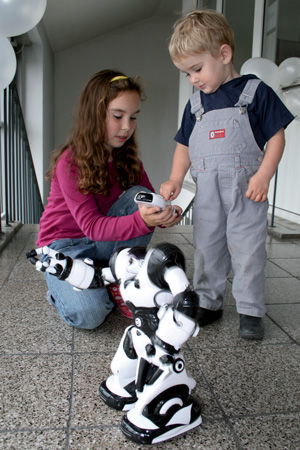by Sybille Hambach
People no longer need to be convinced that e-learning is up to date. However, they still need to know how to develop good e-learning products and services. Researchers at the Fraunhofer Institute for Computer Graphics (IGD) Rostock have developed the process model ROME. It helps experts from different disciplines to understand the process, methods and tools involved in developing e-learning products and services.
The development process for e-learning products and services is very complex. A variety of concepts, methods, tools and scenarios must be considered in order to choose those most suitable for a specific context. Furthermore, experts from different disciplines will contribute to an e-learning product: the topic expert and experts from pedagogy, computer science and design. Each has his/her own terminology and preferred way of discussing alternatives and deciding on a solution. It would therefore be helpful to have a description of the development process that is suitable for all the experts involved and that integrates all the contributing disciplines.
Contributing Approaches
We propose that the development process for e-learning products and services be described using approaches from the engineering disciplines:
- the systems engineering approach is used to structure the development process. It implements four basic principles: (1) from coarse to fine, (2) thinking in variations, (3) phase structure as macro-logic, and (4) problem solving as micro-logic.
- a process model is used to describe relevant components, eg process steps, roles, artefacts and resources (methods, tools, standards etc). A sequence of process steps explains exactly what to do or decide, which experts to involve, the results to be achieved and what resources to use.
- description schemata are used to semi-formally describe each component. They are supplemented by UML diagrams showing the relationships between different components of the process model.
- text schemata from the field of technical documentation are used to describe each component in detail. The resulting text or multimedia documents, eg teaser, procedure, example, reference etc, are very structured but easy to read and understand.
While these approaches originate from engineering disciplines, they are easy to understand for experts from other disciplines; in addition, they are also suitable for describing complex development processes.
The ROME Process Model
Our process model ROME the Rostock model for systematically developing e-learning products and services - supports interdisciplinary teams in developing e-learning products and services.
- it provides (and applies) a basic vocabulary for all team members
- it describes what to do and what to consider while developing e-learning products and services
- it integrates concepts, methods and tools of all contributing disciplines
- it provides instructions for the development of an e-learning product that is best suited to the topic, the target group and the specific context.
ROME is suitable for developing
e-learning products and services for all kinds of scenarios: blended learning, distance learning, cooperative learning, computer-based training, Web-based training and so on. ROME conforms to the 'Reference Framework for the Description of Quality Approaches' for e-learning specified in ISO/IEC 19796-1:2005, and was described as a European-wide good practice in CEN CWA 15660:2007.
Using ROME
ROME has been used to structure a variety of e-learning projects: an educational concept for introducing computers into a kindergarten (see example below) and a primary school, an
e-learning product for teaching the basics of usability, a WBT about safety in the workplace, and a variety of
e-learning products and services for teaching software tools. It was even used to develop the game-based training 'Pfeilstorch' about a biological topic. Furthermore, ROME is suitable for teaching the basics of e-learning as well as for implementing software systems to support e-learning projects. It has thus been used to design and prototypically implement electronic performance support systems for interdisciplinary teams developing e-learning products and services.
An example: Introducing Computers in a Kindergarten
It seems logical that kindergarten kids (aged 4 to 6) should learn how to use a computer. They regularly see people working with computers and it makes sense that they should become familiar with the computer as an everyday working tool. Without much background knowledge, one might simply buy a computer and some computer games for kids - perhaps choosing them according to how they rate in relevant rankings. The computer is then plugged in, the games installed and the kids allowed to play.

Using ROME, one would first look at the need (Why should the kids learn how to use the computer? What can they do with it?), at the kids (What do they already know? What are they able to do?) and the context (What do the parents say? What are the teachers skills? What computers are available or appropriate?). The next step would be to think about appropriate didactic approaches (cooperative, project-oriented, living-world-oriented etc). An overall concept would be specified, including learning material, scenarios, settings and activities, and some of the aspects would be looked at in more detail. One would speak with parents, teachers, technicians and pedagogical experts to validate the concept. Finally, one would set up the learning material, carry out single lessons and evaluate their success. Overall, this process - performed systematically - is not necessarily more complex but provides significantly better results.
Link:
http://www.igd-r.fraunhofer.de
Please contact:
Sybille Hambach
Fraunhofer Institute for Computer
Graphics, Rostock, Germany
Tel: +49 381 4024 110
E-mail: sybille.hambach![]() igd-r.fraunhofer.de
igd-r.fraunhofer.de










